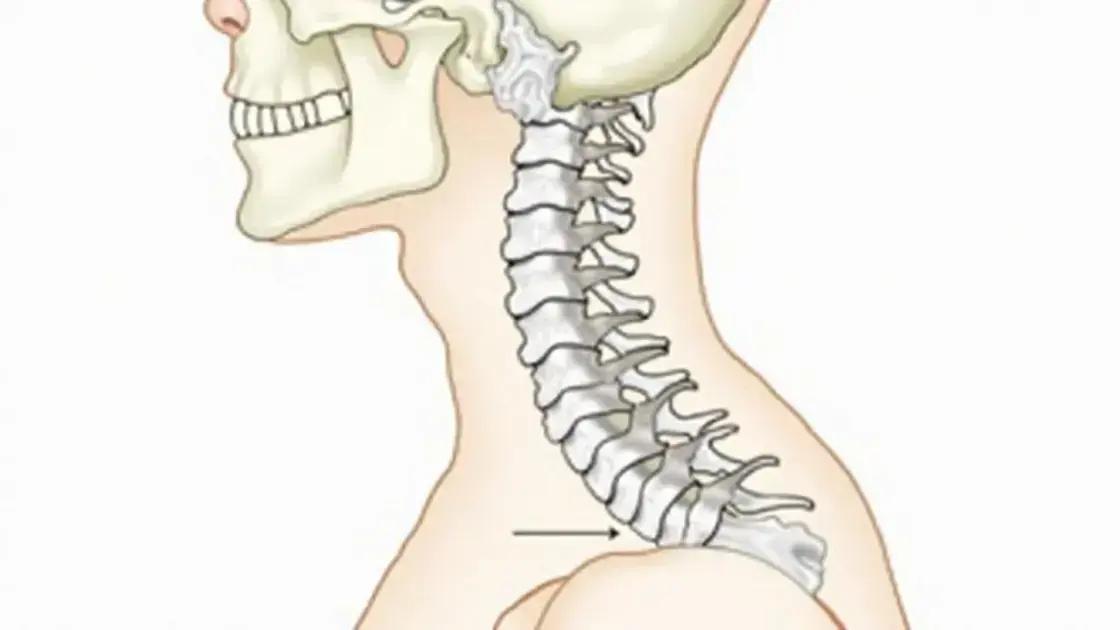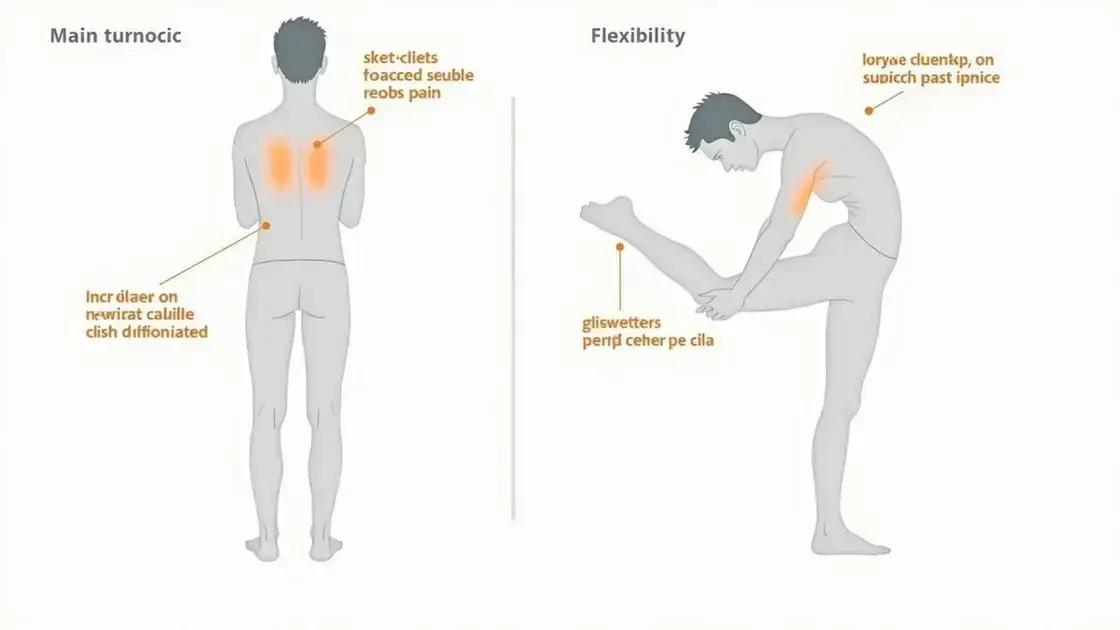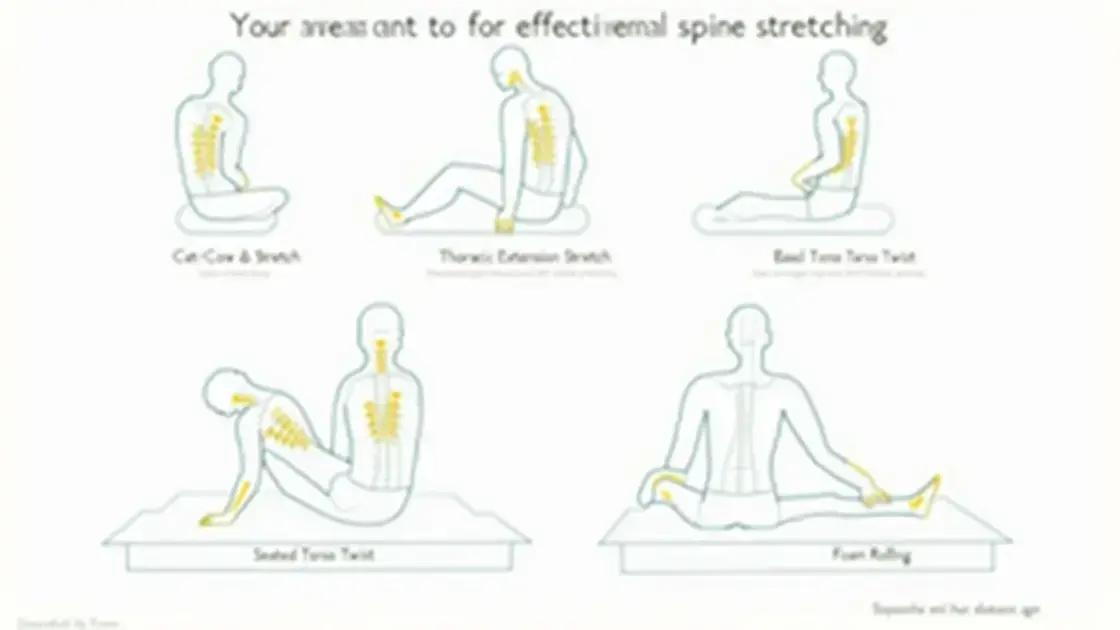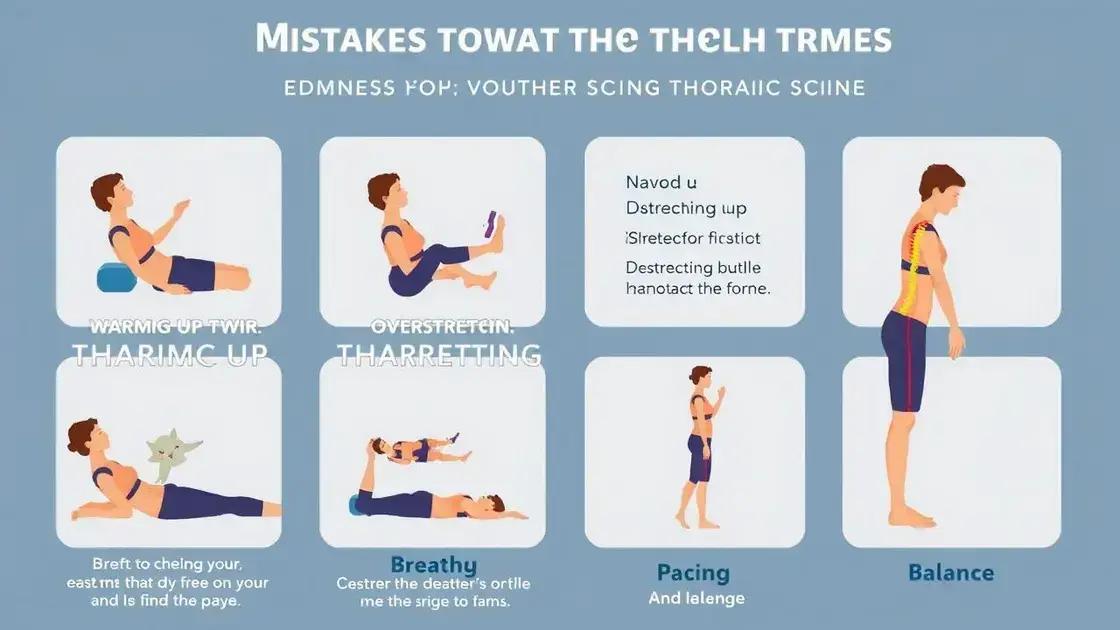The best techniques for stretching the thoracic spine include the Cat-Cow stretch, thoracic extension stretch, seated torso twist, and foam rolling; these practices promote flexibility, relieve tension, and improve posture while avoiding common pitfalls such as overstretching and neglecting warm-ups.
Your thoracic spine plays a crucial role in your overall mobility and health. Implementing the best techniques for stretching the thoracic spine can enhance your flexibility, reduce discomfort, and promote better posture. In this article, we will delve into the anatomy of the thoracic spine, discuss the importance of its stretching, outline top techniques you can easily incorporate into your routine, and point out common mistakes to avoid for effective results.
Understanding the Thoracic Spine Anatomy

The thoracic spine is a vital part of our body, consisting of twelve vertebrae (T1 to T12) located in the middle region of the back. This part of the spine connects the neck’s cervical spine to the lumbar spine in the lower back. Understanding its anatomy is key to appreciating why it requires proper care and stretching.
Structure of the Thoracic Spine
Each thoracic vertebra is unique, featuring a rib attachment point, which is essential for the protection of vital organs. The rib cage, formed by these vertebrae and the ribs, plays a crucial role in safeguarding the heart and lungs while supporting the upper body.
Functionality
The thoracic spine allows for a range of movements, including rotation, extension, and a limited amount of flexion. This flexibility aids in daily activities like reaching and twisting. However, due to lifestyle factors such as working at a desk, many people experience stiffness in this area.
The Importance of Its Curvature
Normal thoracic curvature is critical for distributing weight and maintaining posture. A balanced curvature supports not only the spine but also impacts overall body alignment and movements. A healthy thoracic spine contributes to improved balance and stability.
Now that we understand the thoracic spine’s anatomy, its structure, functionality, and role in body alignment, we can appreciate the need for effective stretching techniques to maintain its health.
Importance of Stretching the Thoracic Spine

Stretching the thoracic spine is crucial for anyone aiming to maintain an active and healthy lifestyle. Regular stretching can help manage pain, improve flexibility, and enhance mobility. Why is this important? Let’s explore.
Relief from Pain
Many people experience discomfort in their upper back and shoulders due to prolonged sitting or poor posture. Stretching the thoracic spine can alleviate tension and pain, helping to ease discomfort after long hours at a desk.
Enhanced Flexibility
As we age or maintain sedentary lifestyles, flexibility often decreases. Regular thoracic spine stretching can maintain and even improve flexibility, making daily activities easier and more enjoyable.
Improved Posture
Stretching helps to counteract the effects of slouching. A strong and flexible thoracic spine promotes better alignment of the spine and shoulders, contributing to overall health and preventing long-term issues.
Boosted Athletic Performance
For athletes, a flexible thoracic spine enhances performance in various sports. Good thoracic mobility allows for improved shoulder function and can contribute to better strength and endurance during physical activity.
Incorporating thoracic spine stretches into your routine can improve daily functions, support overall wellness, and contribute to an active lifestyle.
Top Techniques for Effective Stretching

To effectively stretch the thoracic spine, incorporating various techniques can enhance your flexibility and help prevent injury. Here are some top techniques that are both simple and effective.
1. Cat-Cow Stretch
The Cat-Cow stretch is a gentle way to promote flexibility in your spine. Start on your hands and knees. Inhale while arching your back (Cow), and exhale as you round your spine (Cat). Repeat this cycle several times to loosen up the thoracic area.
2. Thoracic Extension Stretch
Sit in a chair with your feet flat on the floor. Place your hands behind your head, elbows wide. Gently lean back to extend your thoracic spine while pushing your elbows back. This technique opens up the chest and stretches the spine effectively.
3. Seated Torso Twist
Seated torso twists improve spinal rotation. Sit upright on the floor or in a chair. Place your right hand on your left knee and twist to the left, looking over your shoulder. Hold for a few seconds and switch sides. This stretch helps with mobility in the thoracic region.
4. Foam Rolling
Using a foam roller can release tightness in the thoracic spine. Lie on your back with a foam roller placed across your upper back. Roll slowly, allowing the roller to massage your spine. This can help relieve tension and enhance flexibility.
By integrating these techniques into your routine, you can boost your thoracic spine health and improve overall mobility.
Common Mistakes to Avoid When Stretching

Avoiding common mistakes when stretching the thoracic spine is essential for safety and effectiveness. Here are some key mistakes to be aware of:
1. Not Warming Up
One of the biggest mistakes is skipping a warm-up. Always do some light activity to get your blood flowing before stretching. This prepares your muscles and prevents injury.
2. Overstretching
Pushing yourself too far can lead to strains. Stretch until you feel a gentle pull, not pain. Listen to your body and respect its limits to avoid injury.
3. Holding Breath
Another common error is forgetting to breathe. Proper breathing helps to relax your muscles. Inhale deeply before stretching and exhale as you go into the stretch.
4. Rushing Through Stretches
Many people rush their stretching routine. Take your time and hold each stretch for about 15-30 seconds. This gives your muscles enough time to respond and lengthen.
5. Neglecting Balance
It’s important to stretch both sides of your body equally. Neglecting one side can lead to imbalances and discomfort. Make sure to practice stretches on both sides to maintain symmetry.
By avoiding these common mistakes, you can enhance your stretching routine and better promote the health of your thoracic spine.
In Conclusion: Mastering Thoracic Spine Stretching
Incorporating effective stretching techniques for the thoracic spine can greatly enhance your overall health and mobility. By understanding the anatomy of the thoracic spine and recognizing the importance of stretching, you can develop a routine that best suits your needs.
Utilizing techniques such as the Cat-Cow stretch, thoracic extension, seated torso twists, and foam rolling can promote flexibility and alleviate tension. Additionally, being aware of common mistakes, such as overstretching or neglecting to warm up, can help you achieve the best results safely.
Make stretching a regular part of your routine to ensure a healthy and flexible thoracic spine, contributing to your overall well-being and physical performance.
FAQ – Frequently Asked Questions about Stretching the Thoracic Spine
Why is stretching the thoracic spine important?
Stretching the thoracic spine helps relieve tension, improve flexibility, and enhance overall mobility, which is essential for daily activities and athletic performance.
What are some effective techniques for stretching the thoracic spine?
Effective techniques include the Cat-Cow stretch, thoracic extension stretch, seated torso twist, and foam rolling, each promoting flexibility and relieving tightness.
How often should I stretch my thoracic spine?
It’s best to stretch your thoracic spine at least 3-4 times a week, or daily if you are actively trying to improve flexibility and relieve pain.
What common mistakes should I avoid when stretching?
Common mistakes include not warming up, overstretching, holding your breath, rushing through stretches, and neglecting to stretch both sides equally.
Can stretching help with poor posture?
Yes, regular thoracic spine stretching can help improve posture by promoting better alignment and alleviating the stiffness that leads to slouching.
Is it safe to stretch if I have back pain?
It’s important to consult with a healthcare professional before starting any stretching routine if you have chronic back pain to ensure it is safe and appropriate for your condition.












